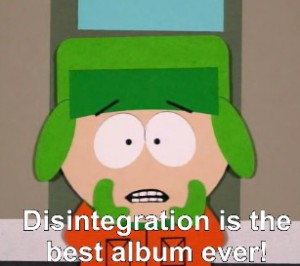
BY HASAN MURAT SÜMER (EE/IV)
hasan.sumer@ug.bilkent.edu.tr
People, including me, often use the adjective “dark” to describe music. It’s not intuitively clear what “darkness” means in music. My understanding is that a dark piece of music should project a feeling of despair or bleakness to the listener. I’ll discuss a few albums from different subgenres of rock to offer my ideas on darkness in rock music.
I have never understood why people listen to Placebo’s music when they can listen to The Cure’s instead. (Who would prefer a placebo to a cure?) The commercial high point for the latter ensemble, one of the best-known alternative rock bands ever, was “Disintegration” (1989), which has the same effect on teenagers as tobacco: it’s nice and pleasurable, but makes breathing difficult and painful. The original gothic style that the band had edged away from for a time returned to their music with this album. But instead of employing their previous minimalistic approach, they incorporated the dark themes using the greater compositional skills they had developed by this time. The theme, plot and lyrics of the album reflect the feelings of a boy after the end of a romantic relationship (it is also possible interpret this using “breakup” as a metaphor), taken to an extreme level: insecurity, hopeless love, loneliness, self-destructive depression and the experience of having loved someone. The second half of the album (tracks 7-12) is the lengthier and more ambitious portion. Highly repetitive instrumental lines create multilayered soundscapes, with the number of layers progressively increasing; it almost feels like trance music. Robert Smith, who was frustrated at the time about the change in the band’s style, sings as if he were the depressed central figure of the album, especially in the second half. His vocals are so full of pain that one can easily see that he was actually depressed during the recording of the album. (The picture is from episode 12 of the first season of “South Park”).
 The style of Dead Can Dance is normally labeled as folk rock, ambient or dark wave. They exhibit a significant influence from the gothic approach and are considered to be one of rock’s darkest bands. Their third studio album, “Within the Realm of a Dying Sun” (1987), provides the perfect music to listen to during a visit to the cemetery. The use of synthesizers and the creation of multilayered soundscapes have great importance here; but along with this ambience, the listener is frequently presented with incongruous instruments such as the oboe, trombone and violin. Unlike Robert Smith’s vocals, those of Lisa Gerrard, who sings in the lowest female vocal range, seem like another instrument, forming another layer in the soundscape. While “Disintegration” projects despair more directly and literally thanks to the lyrics, “Within the Realm of a Dying Sun” expresses it in quite an abstract way. In terms of my analysis concerning degrees of darkness, it is somewhere between “Disintegration” and the next album to be discussed. The recommended serving temperature for this album is below zero Celsius.
The style of Dead Can Dance is normally labeled as folk rock, ambient or dark wave. They exhibit a significant influence from the gothic approach and are considered to be one of rock’s darkest bands. Their third studio album, “Within the Realm of a Dying Sun” (1987), provides the perfect music to listen to during a visit to the cemetery. The use of synthesizers and the creation of multilayered soundscapes have great importance here; but along with this ambience, the listener is frequently presented with incongruous instruments such as the oboe, trombone and violin. Unlike Robert Smith’s vocals, those of Lisa Gerrard, who sings in the lowest female vocal range, seem like another instrument, forming another layer in the soundscape. While “Disintegration” projects despair more directly and literally thanks to the lyrics, “Within the Realm of a Dying Sun” expresses it in quite an abstract way. In terms of my analysis concerning degrees of darkness, it is somewhere between “Disintegration” and the next album to be discussed. The recommended serving temperature for this album is below zero Celsius.
I have chosen the King Crimson album “Red” (1974) to represent mainstream progressive music in this column. Unlike the other two albums, this one has no multilayered soundscapes, and the music is much more intense here. However, there are lots of buildup and jamming sections, and their presence prevents the album from being labeled as hard rock. The lyrics were seemingly forged in despair, and they go well with the raspy vocals of John Wetton. The closing track, “Starless,” starts with a simplistic melody that is haunting enough to be played during the extinction of humankind (even Sagopa Kajmer has sampled it). What follows is a sad, relatively relaxed, but strong section that employs saxophone, cello and mellotron to keep the listener in a melancholic state. The saxophone in this section reminds me of John Coltrane’s smooth segments in “Kind of Blue” (1959). Before reaching even the halfway point of the song, the band slows down and starts to build up tension, intensity and brutality, very slowly. The buildup leads to a loud, fast and creative jamming section. Eventually, this jamming becomes so chaotic that you think the players have totally lost control over their instruments. Soon enough, however, the chaos suddenly turns into one of the most amazing song outros, which reintroduces the melody from the beginning. It goes so quickly that the listener feels a desire to listen to the song all over again, just to listen to the outro after the buildup one more time. “Starless” is the especially bleak track that earns the album a place in this column. It probably would have been the title track if the band hadn’t already released an album called “Starless and Bible Black” (1974).
